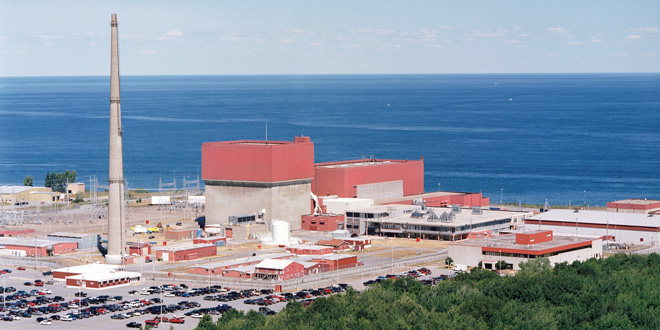By William Opalka
New York’s proposal to subsidize upstate nuclear power plants was blasted as a corporate giveaway and embraced as an economic lifeline and necessity to reduce carbon emissions in comments filed last week with regulators (15-E-0302).
The state Public Service Commission closed the comment period Friday on the cost of the plan’s zero-emission credits. (See NYPSC Extends Comment Period on Nuclear Subsidy.)
Although it was the first time commenters had the opportunity to respond to the projected price tag of the subsidy, the arguments were familiar.
The subsidy was proposed earlier this year as part of the larger Clean Energy Standard. The original proposal pegged the nuclear subsidy as the difference between the average wholesale price of electricity and the operating cost of the nuclear plant. (See New York Would Require Nuclear Power Mandate, Subsidy.)
On July 8, the PSC staff released what it called a “responsive proposal” that calculated ZECs based on estimates of the social cost of carbon. The PSC said that would be $17.48/MWh for qualifying nuclear power generators in the first two years of the 12-year program, or about $965 million.
Staff also modeled the eligibility determination to take into account the costs and benefits of other clean energy alternatives. (See NYPSC: Minimal Cost to Meet 50% Renewable Goal.)
A coalition of environmental groups — including the Alliance for a Green Economy, the Council on Intelligent Energy & Conservation Policy, the Nuclear Information and Resource Service and the Sierra Club’s Atlantic Chapter — continued its opposition.
“After claiming the nuclear tier would cost only $270 million over 12 years, the new ‘responsive proposal’ outlined a plan that will cost nearly $1 billion in just the first two years, with costs escalating to total approximately $7.6 billion. The program will likely cost more than $10 billion if Indian Point gets included,” they wrote.
The Brattle Group, which had done a study last year for New York labor groups, said the subsidy is cost-effective, estimating that electricity costs would rise by an average of $1.7 billion a year between 2015 and 2024 without the nuclear plants. “Although customers would pay for ZECs, they would avoid a power price increase that is larger than the ZEC cost. This means that customers actually pay less overall for power than if the upstate nuclear plants were to shut down.”
Upstate Energy Jobs, a coalition of municipal, business, labor, education and economic development leaders, said it supports the ZECs to keep the plants operating during the transition to clean sources. “Furthermore, renewable energy sources are not being constructed at a pace that makes replacing nuclear power with renewable power a realistic approach at this time.”
Towns and legislative members from western New York also focused on the plants’ economic impact. Comments from the Town of Scriba, which is the site of three nuclear plants, Nine Mile Point 1 and 2 and James A. FitzPatrick, were typical.
“More than any other community in New York state, we are most affected by the potential closure of these facilities should a reasonable and workable solution to the current financial difficulties facing our upstate nuclear-powered electric generators not be realized in a timely manner.”
Exelon is the owner of three nuclear power plants on Lake Ontario, with two in Scriba, and is in negotiations to acquire a fourth. (See Entergy in Talks to Sell FitzPatrick to Exelon.) FitzPatrick has been scheduled to close early next year by its current owner, Entergy. Exelon said it would close Nine Mile Point 1 and R.E. Ginna early next year if a contract is not in place by the end of September.
“Time is of the essence,” Entergy reiterated in its comments.
A group representing large commercial and industrial customers complained that the July 8 proposal is an entirely new formula that is considerably more expensive than what was discussed in earlier proceedings. “In New York’s apparent haste to appease the owners of selected nuclear generation facilities to ensure the continued operation of those facilities, customers are being exposed to potentially 12 years of artificially inflated and excessive subsidy obligations,” it wrote.
Likewise, the National Energy Marketers Association said the proposal interferes with the development of the retail market. “The proposed purchasing and pricing mechanism under which [load-serving entities] will be required to purchase ZECs will have an adverse impact” on energy service companies, it said.
NYISO emphasized the environmental and reliability attributes of the plants. “The state’s nuclear power stations are non-emitting resources that already contribute significantly to the state’s production of clean energy and supply 30% of New York’s energy requirements.”
The Pace Energy and Climate Center supports the ZEC program by emphasizing it as a temporary bridge until renewable energy is built at scale, a point also emphasized by Exelon’s Constellation Energy Nuclear Group.
“While the long-term goal for New York should be to replace the state’s existing nuclear fleet with renewables that are additional to the CES target, over the next 12 years, the governor’s plan to support the state’s nuclear fleet will ensure that New York is able to achieve its carbon emissions targets while making rapid progress towards the CES goal,” Pace wrote.
The American Petroleum Institute proposed an expansive definition of credits for carbon reduction. “The NYPSC must create a level playing field by making emissions credits available to all technologies and energy sources that can reduce net GHG emissions from the electricity sector, including … energy efficiency measures, and other forms of electricity generation that can help achieve compliance with state emission reduction goals, such as natural gas, [combined heat and power], biomass, and waste heat power,” it said.
The PSC could act on the CES at its next regular meeting on Aug. 1.



